![]() Two of the worst problems that plague location sound recording are rumble and wind noise.
Two of the worst problems that plague location sound recording are rumble and wind noise.
Rumble can be defined as unwanted bass vibrations transmitted through objects into the mic capsule itself. Examples of rumble include ground or floor vibrations caused by nearby traffic, heavy footsteps, and building/structural vibrations. In addition to rumble, a closely related malady is that of handling noise -- created by the friction or light tapping of human fingers, either directly against the microphone itself or conducted through whatever means by the microphone is supported (e.g. fishpole).
Merely filtering out the low frequencies at a mixing panel will not correct the whole problem. Low frequencies can quickly overload the pre-amplifiers of some microphones and most recorders. To avoid the risk of permanent audio distortion on your tracks, these low frequencies should be controlled before the signal is processed by the mic electronics (which is where pre-amps come in).
The solution to rumble lies in isolating the microphone from these vibrations by some means of free-floating suspension or non-conductive insulation -- which is the role of a good shockmount.
Not to b e confused with shockmounts are microphone clamps. Although both are intended to fulfill support functions, the difference is that a clamp is merely designed to hold a microphone, not to isolate it from vibration. Clamps are manufactured from conductive, hard materials such as plastics and metal.
e confused with shockmounts are microphone clamps. Although both are intended to fulfill support functions, the difference is that a clamp is merely designed to hold a microphone, not to isolate it from vibration. Clamps are manufactured from conductive, hard materials such as plastics and metal.
Because mic clamps (sometimes referred to as mic stand adapters/holders) are cheap to manufacture, they are supplied free with most microphones. You’ll often find boxes full of them in the A/V supply rooms.
Although clamps may be acceptable for use with relatively insensitive (dynamic) mics such as those found in hotel conference rooms, they should not be used with the highly sensitive shotgun mics associated with professional film and video production.
An example of a mic clamp,
made by Canford
Instead, make it a habit to always use an isolation shockmount.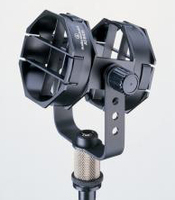
A good shockmount does not have to mean big bucks. For example, some of the most popular shockmounts in use by the professional film and video industry sell for under seventy-five dollars!
Without a doubt, the overall most popular shockmount in use by the video industry is the model AT8415 "rubber band mount" manufactured by Audio Technica (seen right). This inexpensive universal shockmount consists of two pair of thick rubber bands arranged tic-tac-toe fashion within a cylindrical framework. The mic is held inside of the "center square" of the grids formed by the rubber bands.
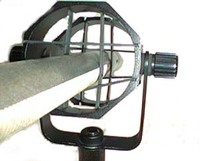 The WRONG way to insert a mic.
The WRONG way to insert a mic.
Simply placing the mic into the center grid
formed by the rubber mounts will NOT
hold the mic securely!
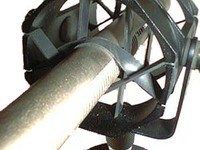 The CORRECT way to insert a mic.
The CORRECT way to insert a mic.
The lower rubber band mount is pulled OVER the top of the mic, and the top band pulled
UNDER the bottom of the mic for a firm grip.
If more tension is required for a heavier mic,
then the two side bands can also be crisscrossed.
Since the AT8415 does not utilize a plastic cradle of fixed diameter, it will support just about any mic on the market except for the longer and heavier shotguns.
Extra support for longer and heavier mics is achieved by criss-crossing the rubber bands so that the mic is firmly sandwiched not only within the top and bottom bands, but also sandwiched within the side bands Even more back support can be achieved by adding a second band directly over the existing band in the vertical plane. You may have to file out the slot a little bit to accommodate the two bands. Heavy duty spare EPDM (Ethylene Propylene Diene Monomer) bands are available from some dealers.
The yoke of the AT8415 is drilled and threaded to accept a 3/8-16 thread-sized mounting stud, such as those found on standard boompoles. A removable adapter is supplied by the manufacturer for use with common mic stands and goosenecks, which have a larger 5/8-27 thread.
The AT8415 is definitely a "best buy" considering its low profile appearance, design simplicity, adaptability to a wide variety of mics, and excellent isolation performance.
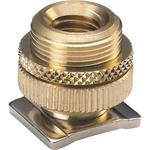 To attach the 8415 mount onto a camcorder, use a 5/8 to camera shoe adapter, such as those available from dealers (seen left, the AT8469 Camera Mount Adapter).
To attach the 8415 mount onto a camcorder, use a 5/8 to camera shoe adapter, such as those available from dealers (seen left, the AT8469 Camera Mount Adapter).
 A useful trick (see right) for making the standard 5/8 adapters more field worthy is to insert a 3/8-16 set screw into the threaded opening in the 5/8 portion of the adapter. Use some thread adhesive or glue to secure it. Then add a small rubber washer where the shaft of the 3/8 screw protrudes from the body of the 5/8 shaft. Finally, slip a rubber O-ring over the entire piece so it rests below the lockdown nut.
A useful trick (see right) for making the standard 5/8 adapters more field worthy is to insert a 3/8-16 set screw into the threaded opening in the 5/8 portion of the adapter. Use some thread adhesive or glue to secure it. Then add a small rubber washer where the shaft of the 3/8 screw protrudes from the body of the 5/8 shaft. Finally, slip a rubber O-ring over the entire piece so it rests below the lockdown nut.
Now, when you attach your 3/8 shockmount to the camcorder, it will fit directly onto the 3/8 to camera shoe adapter and no longer require the removable 3/8 to 5/8 adapter. The friction of the rubber washer will allow you to quickly align the shockmount so that the mic is pointed directly forward (without wrestling with metal friction nuts that never seem to lock down precisely). And the O-ring fills any gaps between the lockdown nut and the camera shoe.
Another shockmount on the market is PSC's Universal Shock Mount. It is inexpensive and uses two rubber O-rings to sandwich the mic at either end. A lot of people swear by them.
K-Tek makes a few excellent shockmounts: namely the K-SM, K-MT, K-GPS, and their variations.
 The K-SM is sort of the flagship of the line (seen left). It uses two polymer mounts that are sort of like an inverted V with a circular center. The center ring stretches to firmly seat most popular shotgun mics, and the inverted supports offer excellent support. This mount is available in standard length, and a short length (K-SSM) for shorter mics.
The K-SM is sort of the flagship of the line (seen left). It uses two polymer mounts that are sort of like an inverted V with a circular center. The center ring stretches to firmly seat most popular shotgun mics, and the inverted supports offer excellent support. This mount is available in standard length, and a short length (K-SSM) for shorter mics.
The K-CAM-SM is the same mount, but with a flat camera shoe instead of a 3/8 threaded swivel mount.
 The K-MT and K-GPS do not utilize the inverted V mounts, but instead rely on a complete 4-point suspension. The heart of both mounts is the K-Tek K-SUS mic suspenders, which can be described as a polymer ring with four loops extending out. Each of the loops is secured to the metal frame of the shockmount. This system provides the utmost in isolation, though not as much hard shock absorbtion.
The K-MT and K-GPS do not utilize the inverted V mounts, but instead rely on a complete 4-point suspension. The heart of both mounts is the K-Tek K-SUS mic suspenders, which can be described as a polymer ring with four loops extending out. Each of the loops is secured to the metal frame of the shockmount. This system provides the utmost in isolation, though not as much hard shock absorbtion.
In plain English, what that means is that the K-SM is better for hard handling, such as ENG "run 'n gun;" and the K-GPS is better for subtle handling of extremely sensitive mics, such as studio feature films & TV. Kind of like choosing shocks for a car: some are better for high speed highway and some are better for rough bumps and rugged terrain.
The K-MT is less expensive, but not as heavy duty, as the higher end K-GPS (seen right).
Shockmounting a miniature microphone such as a lavalier is easier than one might imagine. It is very common to mount small mics onto table tops, walls, and all sorts of props. A short strip of cloth camera or gaffers tape, loosely wadded into a loop or a ball, will suffice. Lavalier mics have very little mass, so they are easily supported by a single thickness of tape. The cloth and adhesive gel of the tape are very efficient at dampening vibration.
An adjunct of shockmounting the microphone is to shockmount the potential source of noise and vibration. The Hollywood industry uses a material known as "foot foam" to cut down obvious trouble areas. Foot foam is adhesive backed, thin neoprene rubber which can be cut and affixed to shoes, boots, glassware, table tops, bases of mic stands, etc.
Foot foam is cheap and expendable; your dialogue track is not.
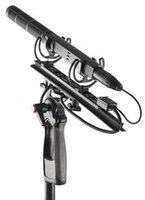 Moving up the scale in terms of quality and price brings us to dedicated pistol-grip shockmounts. An example of which is the Rycote Modular Suspension, shown left.
Moving up the scale in terms of quality and price brings us to dedicated pistol-grip shockmounts. An example of which is the Rycote Modular Suspension, shown left.
Pistol-grip shockmounts are usually designed to accommodate just one or two specific microphones. The mic mounting clips are usually specific in diameter; 19mm and 21mm are the most common. The spacing from front clip to back clip is engineered for specific mic length and mass. The rubber mounts supporting the clips are also optimized for a particular load.
The pistol-grip handles themselves are drilled and tapped to accommodate the standard 3/8" thread found on boompoles. Some of the shockmount manufacturers also offer short boompole mounting yokes in lieu of the handles, but the majority of users prefer the handles.
The pistol grip shockmounts sell for around a couple hundred, give or take, depending on manufacturer, model, and your personal discount.
Of course, another expedient solution is to use a simple handgrip with a built-in 3/8 stud on the end. Just screw it into a standard 3/8 shockmount and now you have a pistol grip shockmount!
But to be honest, most of the pistol grip type shockmounts that one sees here and there are actually just the receiver portion of full zeppelin systems, but without the zeppelin windscreen attached. Very few people purchase pistol grip shockmounts by themselves.
Pistol-grip shockmounts are manufactured by K-Tek (U.S.), Rycote (U.K.), Rode (A.U.), and Sennheiser (Germany).
Over the years, Rycote and K-Tek have been very responsive to the needs of the industry, and keep refining their products into what are generally acknowledged to be the standards of the motion picture and video production industry. A newcomer on the scene is Rode, who also manufacture a full line of shockmounts and blimp windscreens.
One quick note about shockmounts and thread sizes. It has been mentioned that shockmounts come equipped with some sort of mounting hole or adapter for use with fishpoles and mic stands. There are three different thread sizes that you may encounter: 3/8", 5/16", and 5/8".
The current standard thread for fishpoles is 3/8". The slightly smaller 5/16" used to be the standard in Hollywood, but has pretty much been replaced by the more popular 3/8". Older fishpoles and pistol-grip handles may require a simple adapter for use with 3/8".
The larger 5/8" thread size is the standard for mic stands and goosenecks. Most mic clamps are threaded for 5/8", although some are also supplied with a 3/8" insert adapter.
